Scaling Marketing Beyond
Inbound Traffic
For most companies there is a point where they need to scale beyond inbound traffic, Enterprise sales Account Based Marketing, small scale events, PR, analyst relations, sales/marketing collaboration.
For this to succeed you can’t just repeat the tactics that generated inbound traffic. You need a proven strategy for reaching senior decision makers at medium to large sized organisations.
Framework
A practical model for modern B2B growth: awareness → engagement → consideration → purchase → loyalty.
- Why funnels fail in group-based, digital journeys
- What to do at each stage (and how to measure it)
- How AEO/GEO future-proof your visibility in AI answers
B2B journeys aren’t linear. They’re long, messy, and group-based. This post lays out a practical lifecycle—awareness, engagement, consideration, purchase, loyalty—so you can plan work you can actually influence and measure.
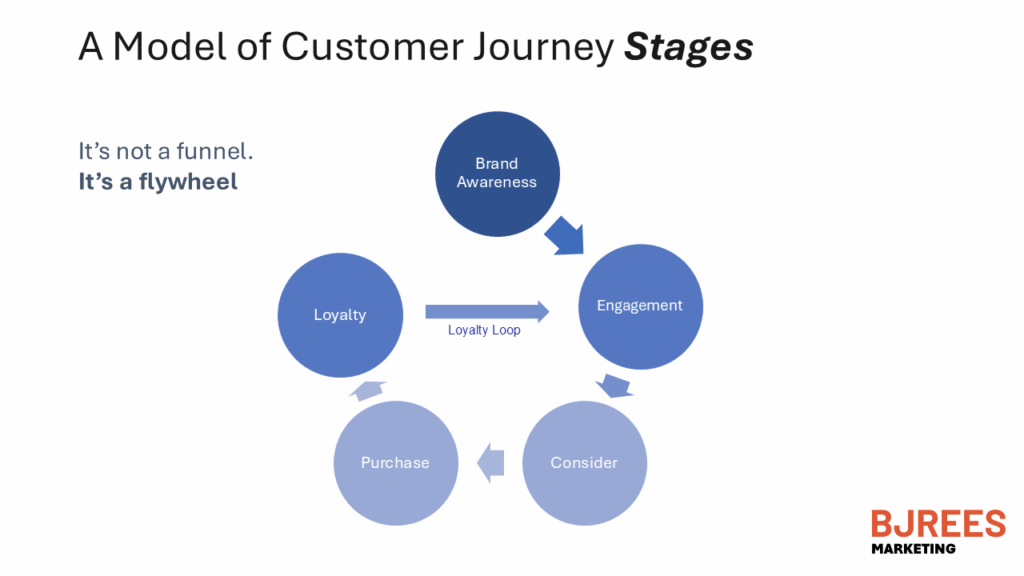
Why the Funnel Doesn’t Quite Work
All models such as this one are very useful particularly for strategy and communication. Of course it isn’t exactly what happens (it’s a model!), but it is there to help you make strategic decisions. But there is a point however where a model is actually unhelpful and misleading, and I think that is the case with B2B marketing.
Modern B2B buying actually involves:
- Buying groups, not individuals—six to ten stakeholders with different needs and risk tolerances.
- Digital-first, fragmented journeys—buyers research across search, peer networks, analysts, communities, and increasingly AI tools.
- No clean handoffs—people loop back, pause for months, and re-enter with new questions; it behaves more like a flywheel.
Journeys with buying groups are hard to track end-to-end; what we can measure is the stage work we do:
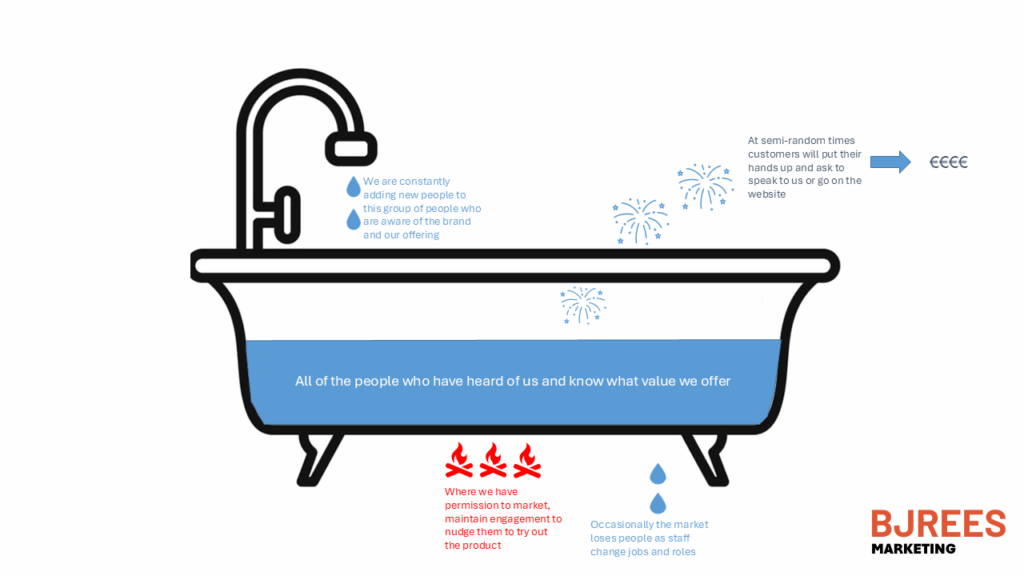
The bathtub analogy is the most useful concept I have found for how marketing actually works in B2B. (NB: at this point it is important to note that B2C is very different to B2B).
What is the idea behind the bathtub analogy? At its core it is purposely breaking the link between what comes inbound in various ways and the opportunities and revenue made at the end. The two stages that are almost completely separate are:
- “Fill the bathtub“. The bathtub represents how many people know about you and what you do. You could be entering a brand new market where literally nobody knows you. You could be a late stage player who is building on top of a very successful business. The late stage business already has a “full bathtub” and their job is just to activate those people in some way. The early stage company doesn’t have anybody in its bathtub and so needs to spend time building its awareness and brand.
- “Heat the bathtub“. great we have all these people that know about us. But that isn’t going to pay the bills. Now you need to activate these people to come in as a lead, to speak to your sales team.
The crucial point here often missed is that those two events could be 10 minutes apart, a day apart, a month apart, or 6 months apart. You need to completely separate these two parts of the “funnel” so that you can manage them separately (likely different teams).
Nevertheless I think it is still very useful that understands this process in stages. This then gives you the ability to examine what is happening at a micro level and optimise where you can.
The Five Stages (at a glance)
Run these stages across end-users and senior decision-makers in parallel. Keep the intent the same; tune the tactics per track.
Stage 1: Awareness
Aim: be known by the right people and linked to a clear expertise.
- Show up where your market already looks (analysts, events, communities, targeted SEO/PR).
- Repeat a simple association: YourBrand = YourExpertise.
Signals: branded search, analyst mentions/SOV, qualified visits from target accounts.
Stage 2: Engagement
Aim: earn permission to keep talking.
- Useful, serialised content and a reason to subscribe or join (newsletter, community).
- Own your voice—credible, empathetic, problem-led.
Signals: engaged subscribers, repeat sessions & depth, community joins, reply rate.
Stage 3: Consideration
Aim: make the shortlist. Shortlist entry ≈ brand salience × portfolio fit × AI visibility.
- Persona-led solution pages; clear integrations and pricing expectations.
- Referenceable proof (stories, ROI snapshots) packaged for internal sharing.
Signals: shortlist adds, high-intent page views, demo requests, stage-qualified opps.
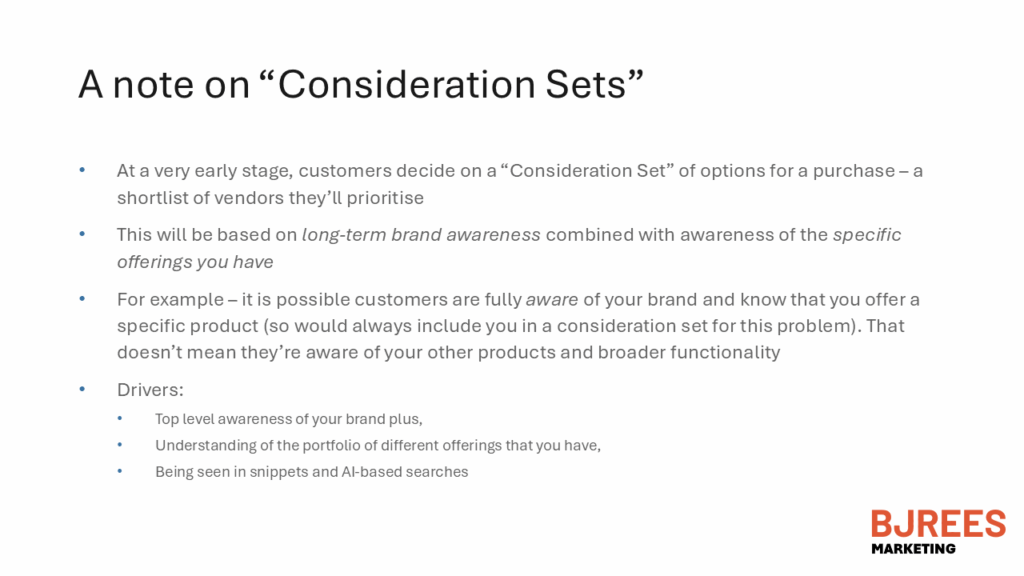
Stage 4: Purchase
Aim: make it easy for the buying group to say yes.
- Buyer-enablement pack: ROI/TCO, security & legal, procurement path, PoC playbook.
- Frictionless trial/demo/PoC and responsive sales–marketing collaboration.
- Self-serve “success centre” page buyers can circulate internally.
Signals: PoCs started/completed, security/legal cleared, win rate, cycle time.
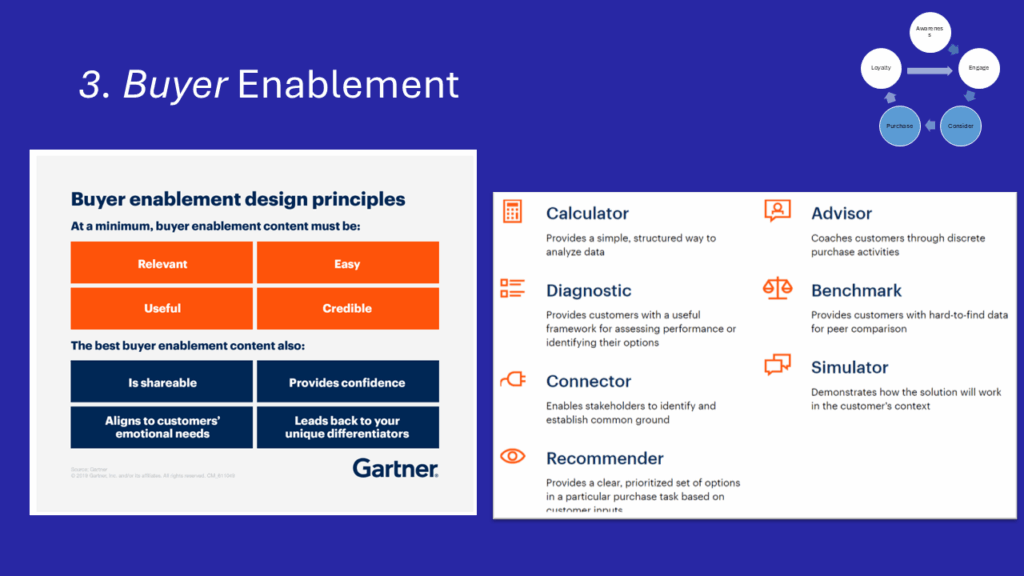
Stage 5: Loyalty
Aim: turn customers into advocates and expansion.
- Onboarding to time-to-value; CS + product signals baked into a cadence.
- Customer marketing: reviews/references, community, expansion playbook.
Signals: activation/adoption, NPS/CSAT, expansion revenue, public advocacy.
Two parallel lifecycles: End-user vs Senior decision-maker
You must win on two tracks at once. End-users discover, try and advocate from the bottom-up; senior decision-makers (SDMs) sponsor, fund and govern from the top-down. Run these lifecycles in parallel and connect them deliberately.
End-user lifecycle (self-serve)
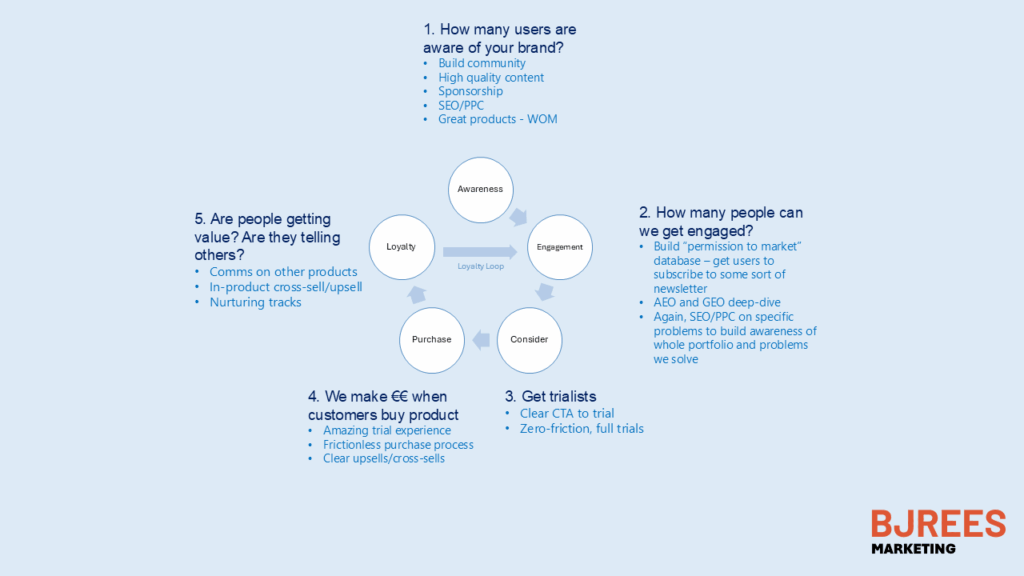
- Awareness → Engagement: tutorials, templates, community posts, searchable docs.
- Engagement → Trial: frictionless signup, sample data, guided tours, checklists.
- Trial → Purchase: usage-based upgrades, in-product paywalls, PQL alerts to sales.
- Value → Advocacy: community, badges, stack showcases, customer stories.
KPIs: signups & activations, WAU/MAU (weekly or daily active users) in target accounts, PQLs, user→team upgrades, community posts.
Senior decision-maker lifecycle (consensus & governance)
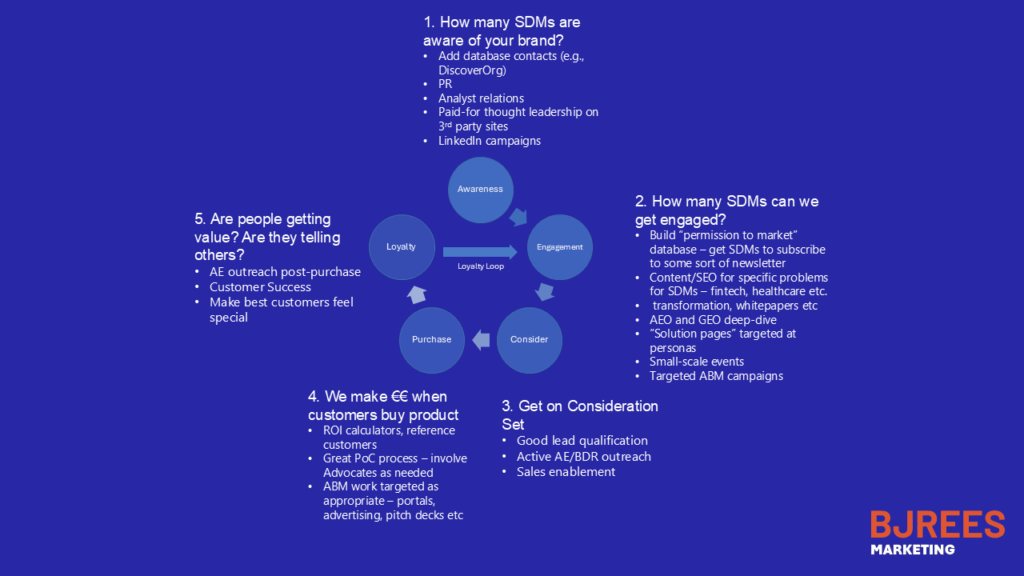
- Awareness → Engagement: narrative & POV, PR/analysts, category page, executive briefs.
- Consideration: persona decks, business-case templates, integration map, risk FAQ.
- Purchase: ROI/TCO, security & IT packs, reference calls, PoC playbook, procurement path.
- Loyalty/Expand: QBRs, value reviews, multi-product roadmap, executive peer forums.
KPIs: target-account engagement, stage-qualified opps, PoCs started, win rate, cycle time, multi-product ACV.
How to run both in parallel
- Ownership split: End-user → PMM/PLG/Content. SDM → Comms/PMM/ABM + AE/SE.
- Cross-over paths: user trial → sponsor kit for managers; exec landing → hands-on demo for teams.
- Shared enablement: reuse security/IT packs and outcomes stories in both tracks.
- Cadence & dashboard: one weekly stand-up; side-by-side metrics (PQLs ↔ SQOs, PoCs, win rate).
Supporting strategies
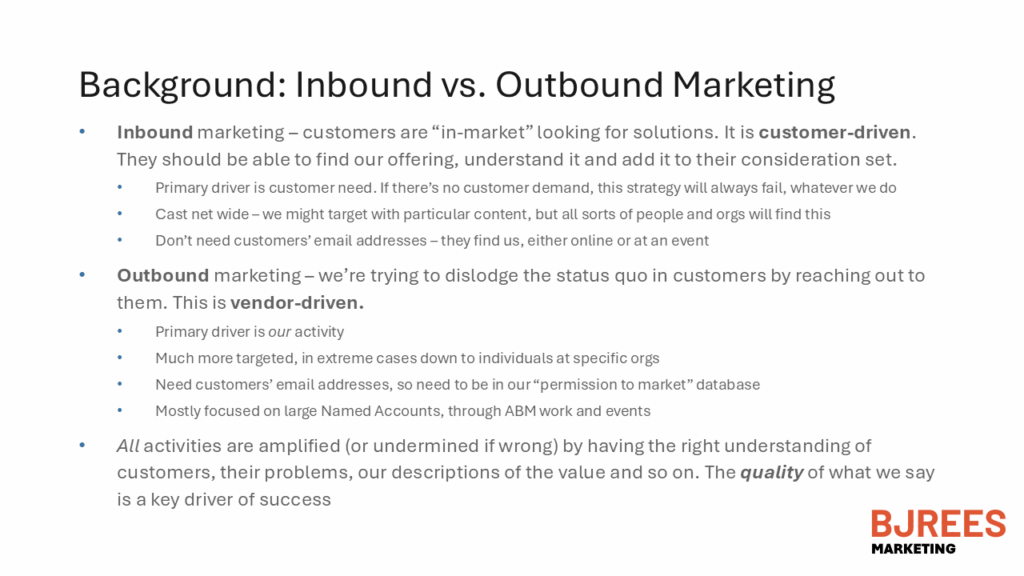
Choose the right mix by segment, using end-user and SDM plays in tandem.
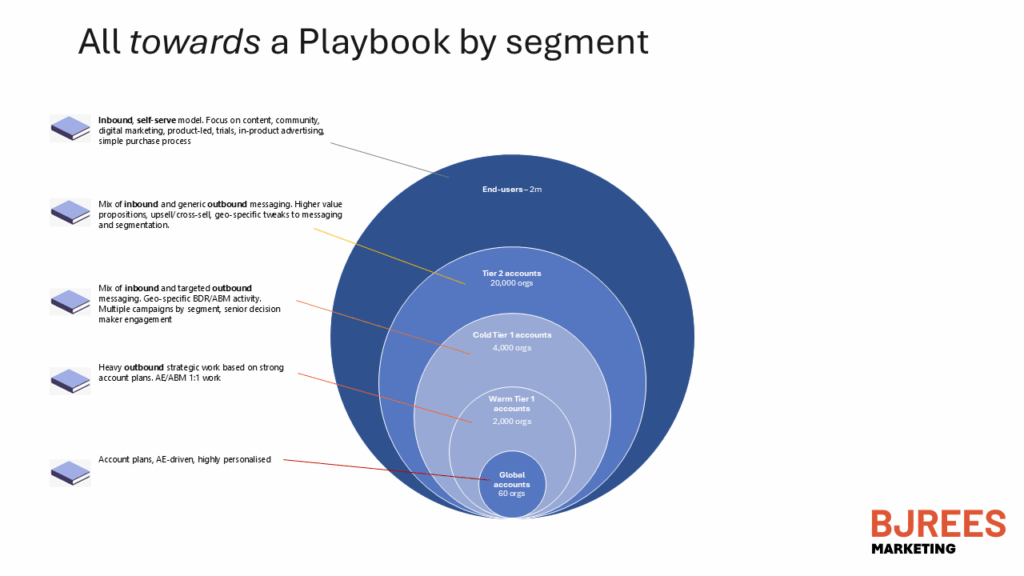
What to Measure at Each Stage
You need to balance short-term P&L with long-term health. This is the trickiest part of this process and requires strong leadership and strategy – we all have to hit targets this quarter but at the same time if you aren’t building for the future you might hit significant problems in a few quarters time, even if you survive this QBR. Track Flow (MQL/MGO/MGR), Balance (database, brand, customers), plus Conversion and Velocity through stages.
- Awareness: branded search, analyst mentions, share of voice, qualified traffic from target accounts.
- Engagement: subscribed contacts, repeat sessions, content depth, community joins, reply rate.
- Consideration: shortlist adds, high-intent page views, solution/ROI asset shares, demo requests, stage-qualified opps.
- Purchase: PoCs started/completed, security/legal cleared, win rate, cycle time, deal quality (ACV, multi-product).
- Loyalty: activation/adoption, NPS/CSAT, expansion revenue, advocacy (reviews, references), community contributions.
Buyer Enablement: Closing the Gap
Give buying groups what they need to say yes:
- Evidence: ROI/TCO models, outcomes case studies, competitive comparisons.
- Risk reduction: security one-pager + detailed pack, data processing terms, implementation plan, success criteria.
- Self-serve access: trial or sandbox with guardrails, demo center, shareable decks/one-pagers.
Ownership & Cross-Linking
- Assign a DRI (Directly Responsible Individual) per stage (e.g., Awareness—Brand/Comms; Engagement—Content/Ops; Consideration—PMM; Purchase—Sales Enablement; Loyalty—CS/CMM).
- Build internal links that mirror buyer movement (Engagement ↔ Consideration; Consideration → Purchase; Loyalty → Awareness via advocacy).
Future-Proofing: AEO and GEO
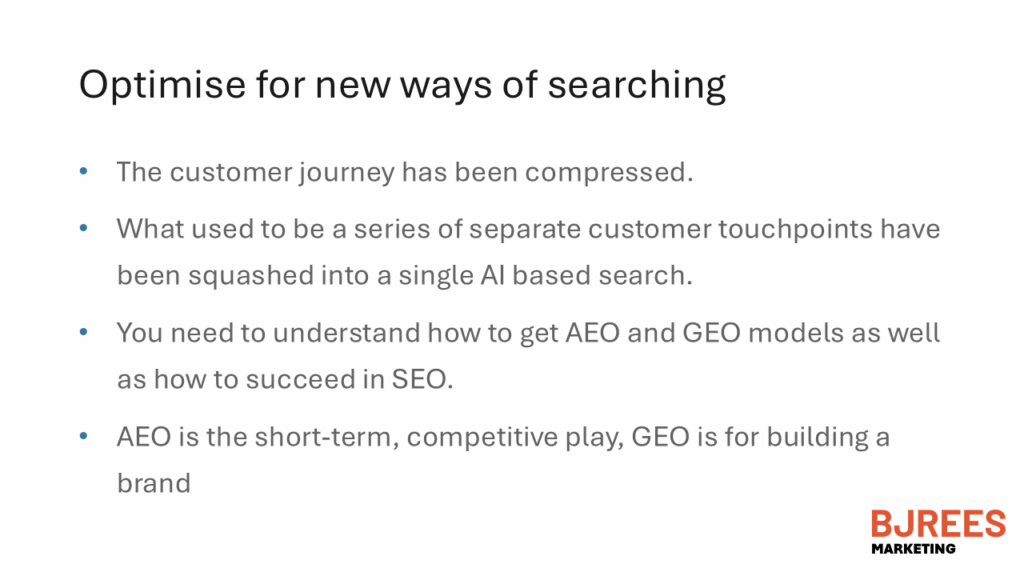
AI compresses what used to be separate touchpoints into a single query. Treat AEO as the short-term competitive play – FAQ/Article/HowTo schema, crisp definitions, clear Q→A blocks. Treat GEO as brand building inside the models – authoritative content, presence in trusted sources, consistent metadata, durable signals of expertise.
For a deeper dive, see my white paper: Why GEO Matters More Than SEO.
Conclusion
It’s not a funnel—it’s a lifecycle. Design for the stages buyers actually move through, measure the few signals that matter, remove friction at purchase, and turn customers into advocates. That’s how you become the name people remember, choose, and recommend.
